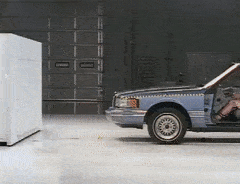
In 1953, John Hetrick, an American engineer, designed the first "safety cushion" after being in a car accident with his wife and 7-year old daughter [1]. Airbags became a compulsory component in automobiles in the nineties, but what was meant to keep people safe still posed a huge threat to women and children [3].
It wasn't until 2008 that the National Highway Traffic Safety Administration (NHTSA), and the Department of Transportation (DOT) published a document requiring airbags to be tested with a "small female crash test dummy" [2]. That means for almost 20 years, airbags weren't being properly tested on female dummies, putting women and children at a much higher risk for injury or death in accidents.
A study at the University of Virginia found seatbelts put women at a 47 to 71 percent higher risk of getting seriously injured in an accident than men in a comparable accident [3].
ABC News asked Dr. David Lawrence, director of the Center for Injury Prevention Policy & Practice at San Diego State University, why car makers failed to account for female physiology when testing vehicles. He replied:
That is an entire half of the population that's unaccounted for, showing the huge diversity problem in the engineering field.
(The ABC News report: https://abcnews.go.com/Business/female-crash-dummies-injured/story?id=16004267)

In a Washington Post article written by Katherine Shaver, she writes that the 2011 model of the Toyota Sienna, a popular family car, received two out of five stars on the frontal crash test. This was a fall from the top five-star rating on the Sienna’s 2010 and older models. What's interesting is that for the 2011 models, the federal government replaced an average-size male dummy with a smaller female dummy for some tests. When the 2011 Sienna hit a barrier at 35 mph, the female dummy in the front passenger seat registered a 20 to 40 percent risk of being killed or seriously injured, according to the test data. The average for that class of vehicle is 15 percent, which explains the poor safety rating [4].
The airbag story is a prime example of how supporting diversity and inclusion in engineering isn't just a nice and progressive thing to do- it's a necessity. To solve complex problems, there needs to be a diverse set of perspectives and skills. By not diversifying the field, we are not tapping into the talent and intellect that's out there and missing out on the huge potential for innovation.
Sources: